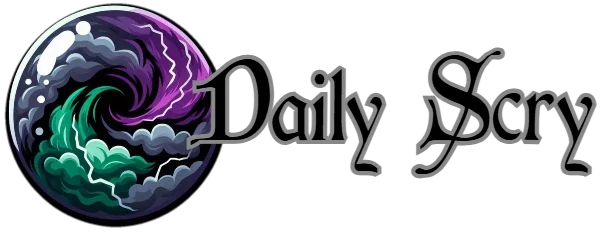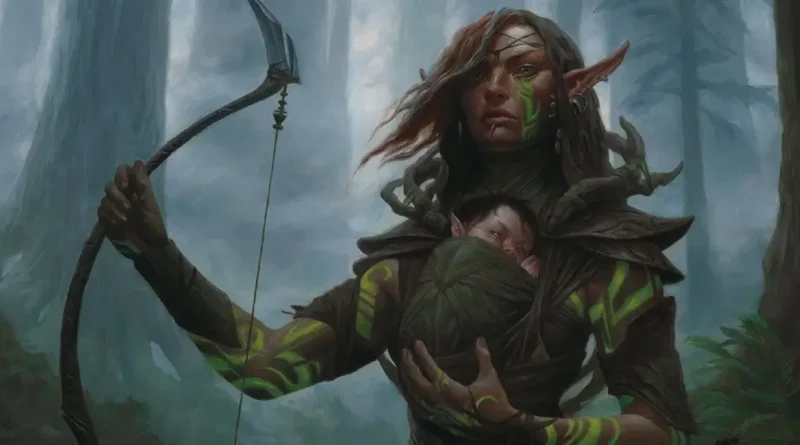Best Elf Commanders in 2025
When I think of my first experiences of fantasy, and, indeed, with Magic: The Gathering, Elves are one of the first creature types that come to mind. As deadly as they are majestic, Elves combine some of my favourite aspects of deck building, blending ramp potential with huge armies of tokens.
If, like me, you’ve ever wanted to flood the board with an army that fuels your mana and can hit like a green-powered freight train, Elf tribal is for you. Elves are one of the most iconic tribes in Magic, known for snowballing mana production, swarming the battlefield, and turning small creatures into game-ending threats.
In this list, I’ve rounded up the best Elf commanders for 2025, grouped by colour identity so you can find the perfect match for your deck’s mana base and playstyle. Whether you’re building your first deck, or you’re on the hunt for a tenacious and fearsome creature type to build a your next deck around, there’s an elf commander ready to lead your warband.
What Makes Elf Commanders Unique?
Elf typal EDH decks excel at two things: explosive mana ramp and overwhelming board states. Your small creatures aren’t just attackers – they’re mana dorks, token generators, and synergy engines that power up as the game goes on. Most Elf decks can pivot between swarm tactics and massive finishers, making them a flexible and deadly choice in Commander.
Strengths
- Exceptional ramp and mana-fixing from low-cost creatures
- Access to huge kindred buffs and game-ending combat swings
- Resilient token production to rebuild after board wipes
- Consistent synergy across almost every Elf card printed
Weaknesses
- Vulnerable to board wipes and mass removal
- Often relies heavily on creatures – few alternative win conditions
- Can struggle against stax or heavy control strategies
Common Archetypes
- Go-Wide Aggro – Flood the battlefield with cheap creatures and overwhelm opponents
- Combo Ramp – Generate massive mana and win with a single explosive turn
- Midrange Buffs – Build a steady board and scale up with lord buffs
- Elfball – Chain mana dorks into draw engines for unstoppable turns
Mono-Green Elf Commanders
Mono-green is the classic home of Elf tribal, and for good reason. It delivers huge mana ramp, consistent token generation, and some of the best tribal payoffs in the format. These decks usually play “Elfball” style – chaining cheap creatures into draw engines and ending the game with overwhelming combat swings.
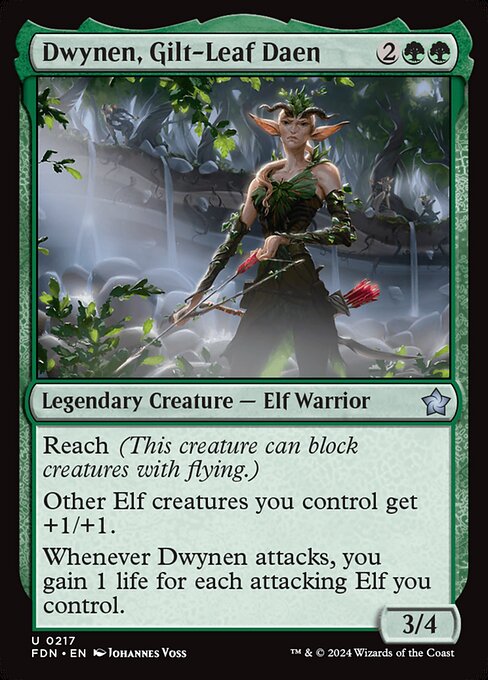
Dwynen, Gilt-Leaf Daen
Dwynen is a straightforward but powerful Elf commander, combining an anthem effect with built-in lifegain. She boosts all your Elves with +1/+1 and rewards aggressive combat by gaining you life whenever your army attacks. That makes her both a buffer and a stabiliser in grindy games.
She shines in go-wide Elf strategies that want to flood the board with cheap creatures and swing every turn. The lifegain keeps you safe from crack-back damage, while the anthem makes your 1/1 tokens into a serious threat. She’s not flashy, but she’s reliable and effective in classic Elfball builds.
Cards like Dwynen’s Elite and Lys Alana Huntmaster keep the tokens flowing, ensuring Dwynen’s anthem and lifegain stay impactful. Priest of Titania or Elvish Archdruid provide the mana to power out your swarm, while Wellwisher offers more lifegain to push your advantage even further.
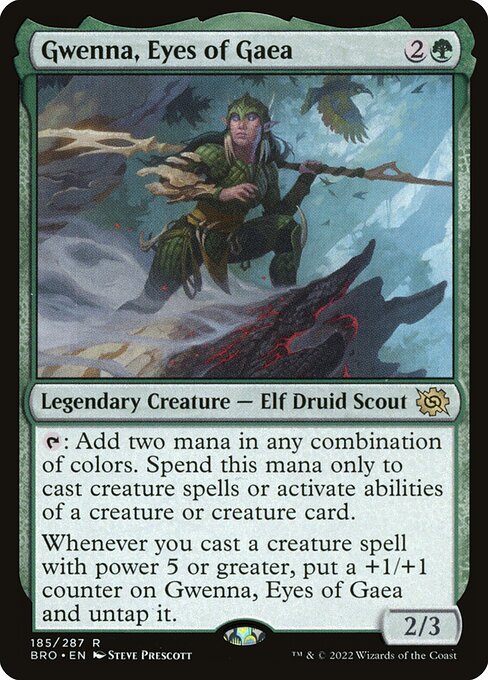
Gwenna, Eyes of Gaea
Gwenna is a powerful ramp engine in the command zone, tapping for two mana in any combination of colours – but only for creature spells or creature abilities. She untaps and grows whenever you cast a creature with power 5 or greater, which means she fuels big plays while scaling into a threat herself.
She thrives in creature-heavy Elf decks that want to ramp into oversized threats. While most Elf tribal lists lean into go-wide strategies, Gwenna pushes you towards a “go-big” plan, focusing on high-power creatures that keep her untapping and growing while you flood the board.
Goreclaw, Terror of Qal Sisma and Ghalta, Primal Hunger turn Gwenna’s mana into explosive board presence, untapping her as you slam oversized threats. Defiler of Vigor and Silverback Elder pile on extra value from each creature cast, while Garruk’s Uprising keeps the cards flowing and gives your team trample to close out games.
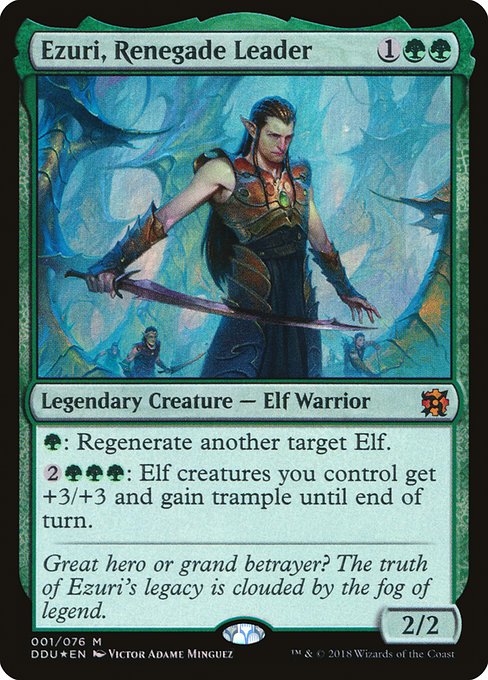
Ezuri, Renegade Leader
Ezuri is the quintessential Elf tribal commander, combining protection and finishing power in one package. His first ability lets you regenerate other Elves, ensuring your key pieces survive board wipes and combat trades. More importantly, his activated Overrun effect gives all your Elves +3/+3 and trample for , transforming a wide board into a lethal army.
He’s best in go-wide “Elfball” builds that produce large numbers of tokens and mana dorks. Ezuri ensures those small creatures aren’t just fodder – they become the backbone of game-ending combat phases. His regeneration also helps maintain momentum after opponents try to clear the board. With that said, as useful as his activated abilities are, there are much better mono green elf commander options out there, but he’s still a solid choice to include elsewhere in your deck.
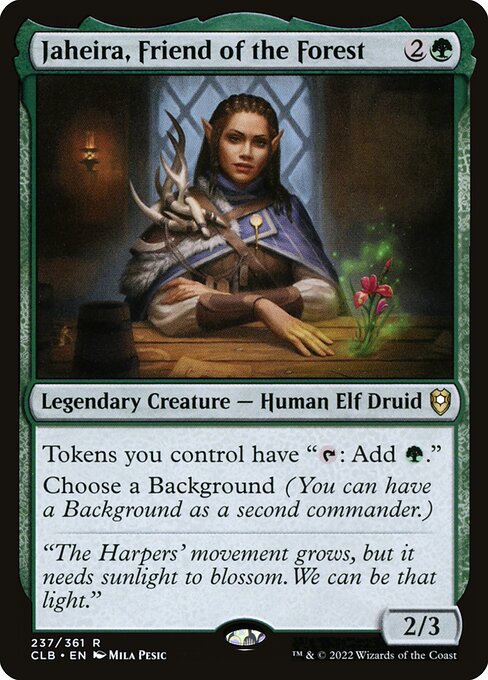
Jaheira, Friend of the Forest
Jaheira transforms token swarms into an incredible mana engine. By giving all your tokens the ability to tap for , she ensures that even a board of 1/1 creatures or noncreature tokens like Treasures and Clues become part of your ramp strategy. This makes her both versatile and explosive in the right shell.
She thrives in go-wide decks that focus on producing tokens, whether that’s Elf tribal, token-creation engines, or Background-based synergies. With a Background partner, you can steer the deck toward pure ramp, aristocrats-style sacrifice, or hybrid token strategies that balance aggression and value.
Pairing her with Cloakwood Hermit or Feywild Visitor gives you repeatable token production that doubles as ramp under Jaheira. Cultist of the Absolute makes her a serious combat threat while feeding off spare tokens, while Raised by Giants or Popular Entertainer can shift your build into an aggressive, table-shaping role.
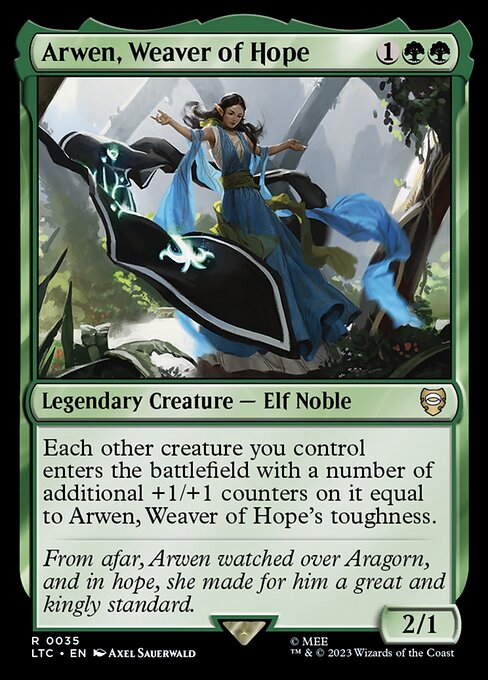
Arwen, Weaver of Hope
Arwen supercharges your creatures by letting each one enter with additional +1/+1 counters equal to her toughness. Even as a modest 2/1, she steadily grows your board, turning small Elves and token-makers into far more dangerous threats.
She’s best suited for counter-based Elf strategies or green decks that naturally want to grow their creatures over time. Because her effect scales with her toughness, she also lends herself to builds that buff or protect her, ensuring your army enters the battlefield stronger and stronger.
Durable Handicraft and Hardened Scales accelerate her counter growth, turning even small creatures into real threats. Protective gear such as Darksteel Plate or Whispersilk Cloak ensures she stays on the battlefield so those buffs never stop building.
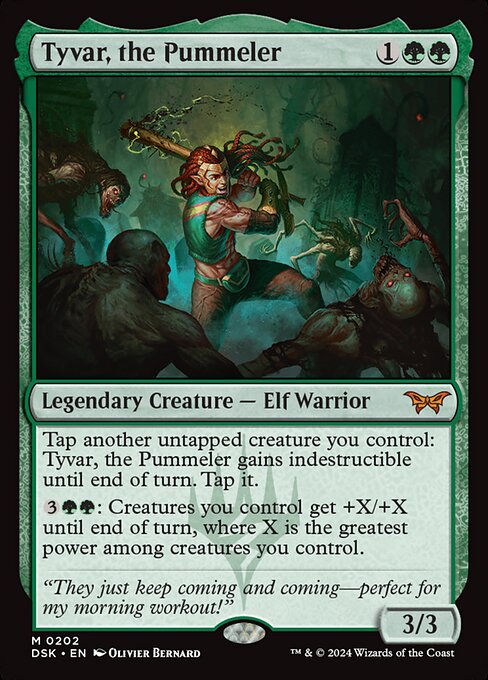
Tyvar, the Pummeler
Tyvar brings resilience and finishing power to the table. He can gain indestructible at instant speed by tapping another creature you control, making him very difficult to remove. His second ability scales your entire board by the greatest power among your creatures, turning even a modest Elf army into a lethal strike.
He thrives in aggressive Elf builds that lean into “go-tall” strategies or want to balance wide boards with a single massive threat. Since he’s hard to kill, he also serves as a reliable centerpiece in midrange decks that rely on keeping their commander in play to push damage.
Mossbridge Troll sets absurd power benchmarks for Tyvar’s pump, while Inspiring Call provides both protection and card draw that align with his indestructibility theme. For added board-wide pressure, Bramble Sovereign doubles up your biggest threats to push his scaling even higher.
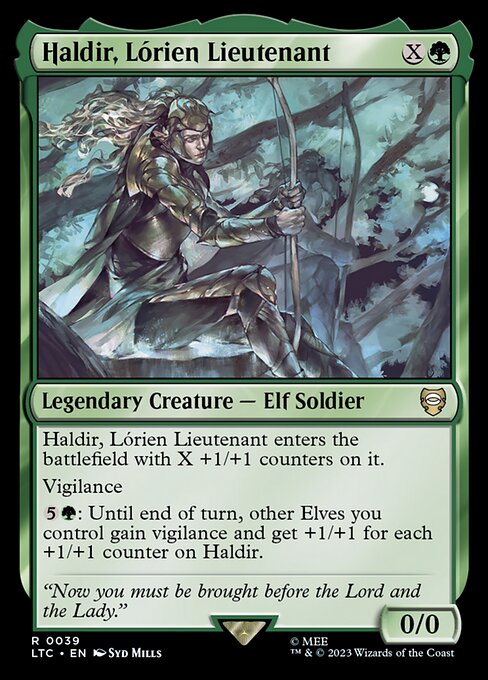
Haldir, Lórien Lieutenant
Haldir is a flexible Elf commander that grows with the game. He enters the battlefield with X +1/+1 counters, letting you scale him to your curve, and his vigilance keeps him both an attacker and a defender. His activated ability turns those counters into a powerful anthem for your entire Elf army, giving them vigilance and a scaling buff.
He fits best in counter-focused Elf builds that emphasise gradual growth before unleashing overwhelming combat phases. Unlike purely token-based Elf commanders, Haldir rewards investing in big mana and scaling counters rather than swarming quickly.
Cards like Forgotten Ancient and Ivy Lane Denizen steadily feed him more counters, making his team-wide pump stronger over time.
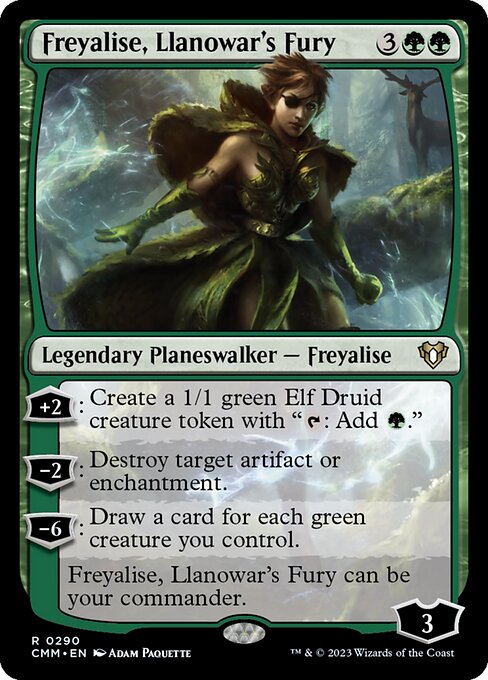
Freyalise, Llanowar’s Fury
As the only planeswalker Elf commander, Freyalise offers a versatile toolkit in the command zone. Her +2 steadily creates mana-producing Elf tokens, her -2 deals with problematic artifacts and enchantments, and her ultimate can draw you a new hand based on how many green creatures you control. This combination makes her a flexible and self-sufficient commander.
She thrives in token-heavy Elf builds where her abilities compound on one another – the Elf Druids she creates not only ramp you into bigger plays but also fuel her ultimate by padding your creature count. She also functions as a support piece in builds that need removal in the command zone.
Doubling Season and Parallel Lives supercharge her +2 ability, flooding the board with Druids that ramp mana and draw cards. The Chain Veil takes things further by enabling multiple activations each turn, accelerating both token production and card advantage.
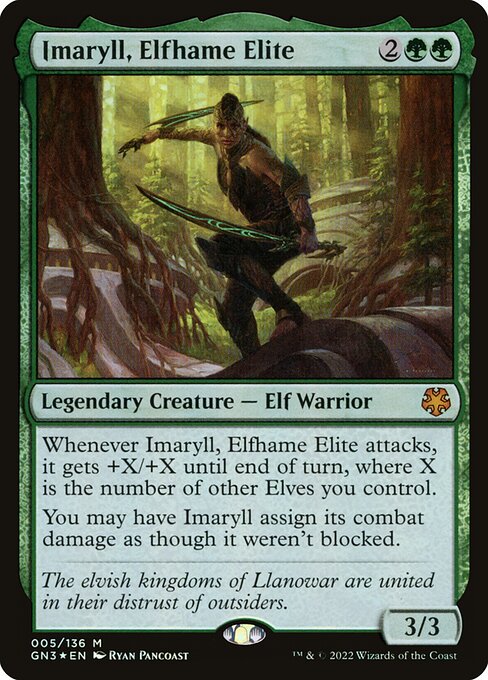
Imaryll, Elfhame Elite
Imaryll is a straightforward but devastating combat commander. Every attack turns her into a massive beater, gaining +X/+X where X is the number of other Elves you control. Since she can assign damage as though she weren’t blocked, she converts your board presence directly into commander damage without worrying about chump blockers.
She shines in classic go-wide Elf tribal decks that aim to flood the battlefield. Imaryll rewards you for building tall and wide at the same time – she scales off the swarm and uses it to pressure opponents directly through unblockable commander swings.
Elvish Promenade and Sylvan Offering flood the board with tokens that directly fuel Imaryll’s power. Triumph of the Hordes can then turn one massive, unblockable swing into a sudden kill, while Quest for Renewal keeps the team untapped to defend and amplify her next attack.
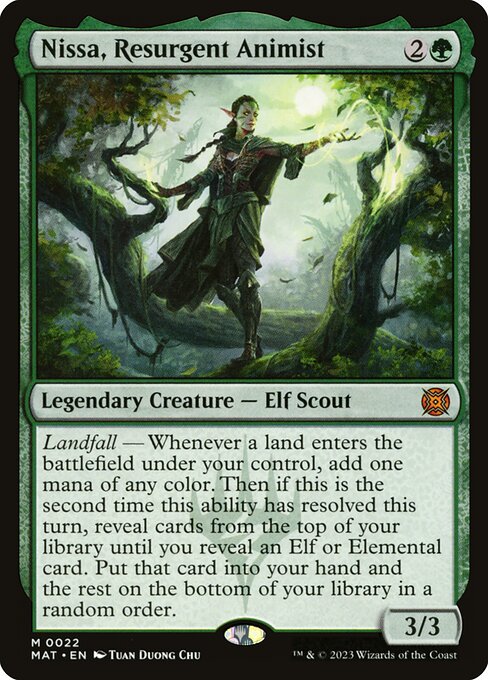
Nissa, Resurgent Animist
Nissa combines mana acceleration with card advantage, all tied to landfall. Each land drop adds one mana of any color, and the second landfall in a turn digs into your deck to find an Elf or Elemental, keeping your hand stocked with creatures. This makes her both a ramp piece and a consistent source of card flow.
She’s at her best in landfall-focused decks or Elf tribal builds that run extra land drops. Fetchlands, bounce lands, and ramp spells let you trigger her twice per turn, ensuring you get both mana and reliable creature tutoring. She leans toward a more midrange playstyle than all-in Elfball, but still fits tribal synergies.
Exploration and Azusa, Lost but Seeking give you extra land drops to maximize her triggers, while Crop Rotation or Harrow can force multiple landfall activations in a single turn. Cards such as Ashaya, Soul of the Wild and Ancient Greenwarden slot into this deck nicely, being both elementals and landfall creatures.
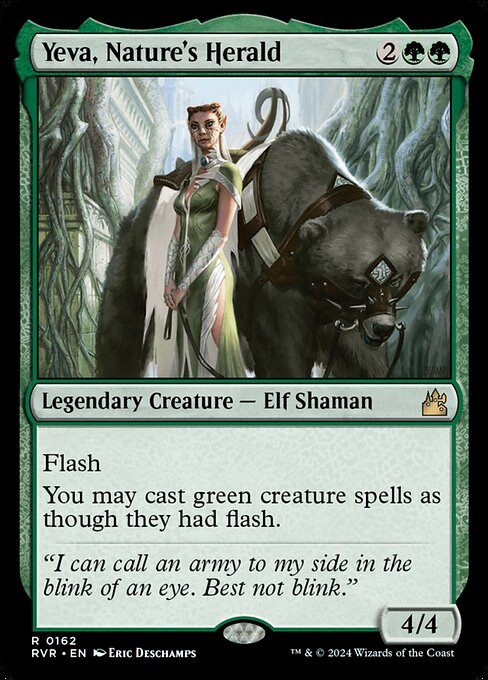
Yeva, Nature’s Herald
Yeva brings speed and flexibility to the command zone. With flash herself, and the ability to give all your green creatures flash, she allows you to play entirely at instant speed. That means you can hold up mana for interaction, then deploy your board on opponents’ turns without missing tempo. I really like how this type of strategy keeps opponents on their toes.
She shines in Elf tribal decks that want to dodge sorcery-speed removal or keep opponents guessing. Flashing in an army before your turn can set up explosive strikes, or let you recover immediately after a board wipe. She also doubles as a great control tool, ensuring your mana is never wasted.
Seedborn Muse is a standout partner, letting you untap every turn and keep flashing in creatures across the table. Vedalken Orrery or Emerald Medallion deepen the flash-ramp synergy, while utility creatures like Reclamation Sage or Endurance become even more dangerous when you can deploy them at instant speed.
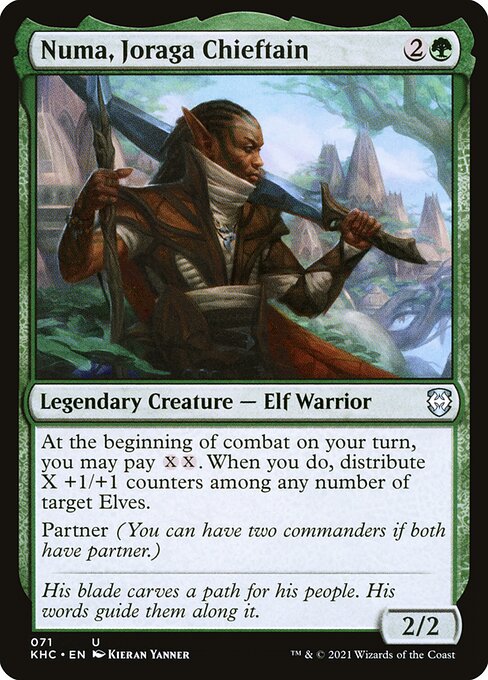
Numa, Joraga Chieftain
Numa steadily converts mana into permanent buffs. At the beginning of combat, you can pay to distribute X +1/+1 counters among your Elves, letting your board scale in size turn after turn. As a Partner commander, he can pair with another legend to cover weaknesses or diversify strategies.
He’s best in Elf decks that generate huge amounts of mana, since he gives you a reliable outlet to turn excess resources into combat power. Over time, he makes even small token creatures threatening, and in longer games he ensures your board keeps pace with more explosive strategies.
Rosheen Meanderer (as a Partner) gives you mana directly for X-abilities, while Gyre Sage and Incubation Druid naturally scale alongside Numa’s counter plan. Joraga Warcaller fits perfectly here, too – multiplying the payoff of every +1/+1 counter you spread across the team.
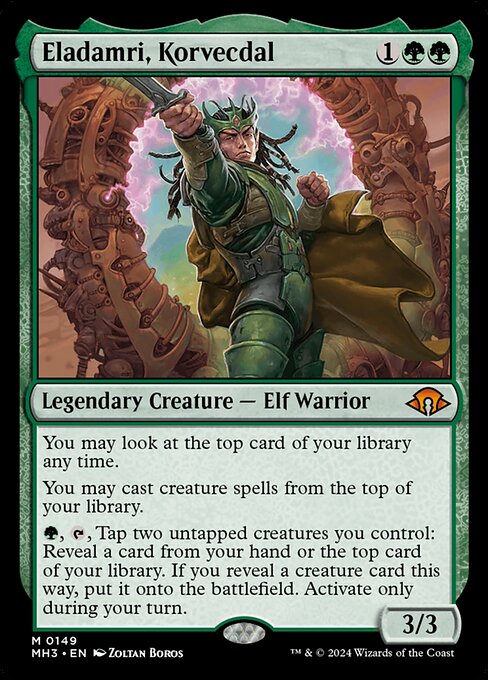
Eladamri, Korvecdal
Eladamri gives you constant access to creatures by letting you cast them directly from the top of your library. On top of that, his activated ability can cheat a creature from your hand or the top of your deck straight onto the battlefield, provided you can tap two other creatures. This makes him both a source of card advantage and a cheat engine.
He fits best in Elf decks that want to maintain constant pressure and never run out of gas. With the tribe’s natural density of creatures, Eladamri ensures your top-deck always stays live. His cheat effect also opens up space for bigger green creatures than usual, since he can bypass their high mana costs.
Cards like Sylvan Library or Sensei’s Divining Top give you control over your top card, ensuring you always have a creature to cast or cheat into play. Genesis Hydra and Duskwatch Recruiter synergize perfectly, helping dig for more creatures to chain off Eladamri’s effect. Low-cost Elves such as Llanowar Elves and Elvish Mystic are also excellent here, since they ramp early and later provide the extra bodies you need to activate Eladamri’s cheat ability.
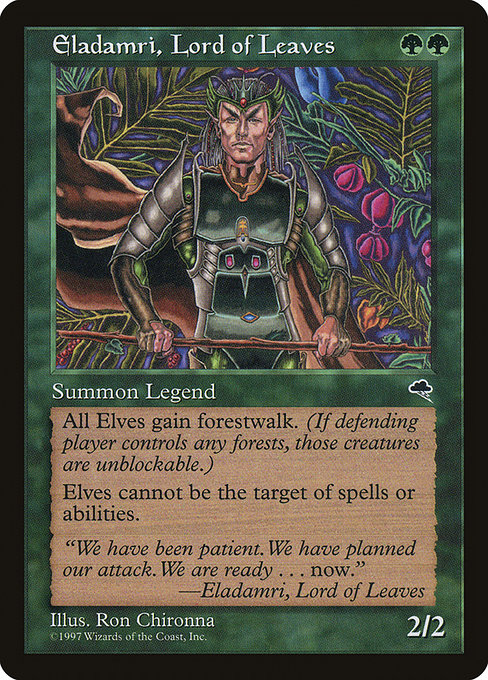
Eladamri, Lord of Leaves
Eladamri is a classic Elf commander who protects the tribe better than almost anyone else. By giving all your other Elves shroud, he makes them nearly impossible to target with removal or disruption. On top of that, forestwalk provides natural evasion against any green player at the table, often guaranteeing combat damage.
He’s best in Elf tribal lists that want to lean fully into combat dominance. The protection he grants allows you to commit heavily to the board without fear of targeted removal, while the evasion gives your swarms a way to cut through stalled boards in green-heavy metas. The trade-off is that shroud also prevents you from targeting your own Elves with buffs, so your build needs to rely more on global effects.
Global pump spells like Overrun or Beastmaster Ascension bypass the shroud restriction and let your army close games quickly. An obvious choice in this deck is Yavimaya, Cradle of Growth, which turns all lands into forests, meaning you can take full advantage of your elf army having forestwalk.
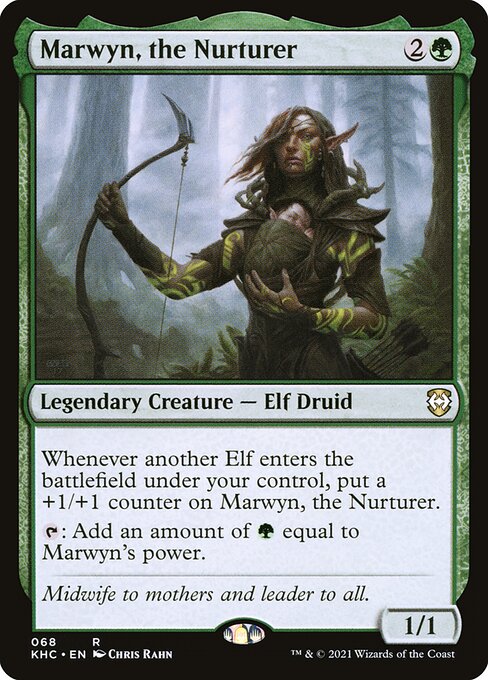
Marwyn, the Nurturer
Marwyn starts small, but every Elf that enters your battlefield adds a +1/+1 counter to her. That scaling turns her into both a large threat in combat and a mana engine, since she taps for green equal to her power. With enough creatures entering, she ramps harder than almost any other Elf.
She thrives in Elfball strategies that want explosive turns. Because she grows passively as you develop your board, Marwyn often ramps from small boosts into game-winning amounts of mana, enabling massive spells or chaining out your whole deck.
Quirion Ranger and Wirewood Symbiote untap Marwyn for repeated bursts of mana, while Umbral Mantle turns her growth into an infinite combo. Token generators such as Lys Alana Huntmaster keep her scaling quickly and fuel the engine at the same time.
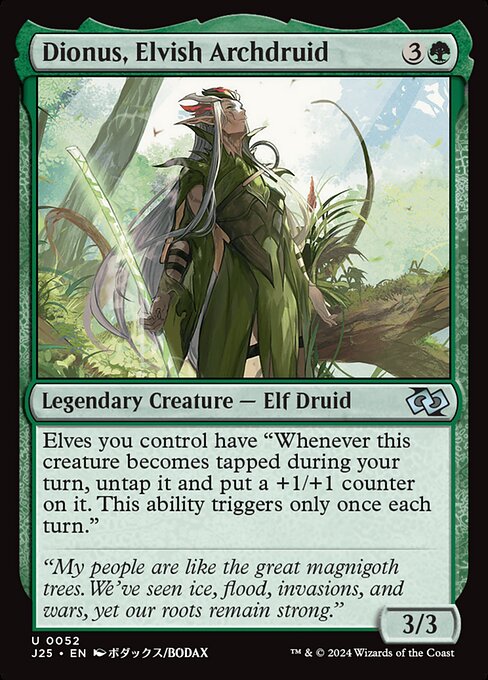
Dionus, Elvish Archdruid
Dionus gives all your Elves a unique upgrade – whenever they become tapped during your turn, they untap and gain a +1/+1 counter, once per turn. This effectively doubles your tapping efficiency while steadily scaling your board with permanent buffs. Even your weakest mana dorks quickly become credible attackers.
He’s best in Elf decks that want to maximize tapping synergies, whether for mana production or activated abilities. Dionus rewards traditional Elfball play patterns, where you’re tapping creatures to ramp and then swinging with a board that’s already bigger than it looks. He also fits naturally into counter-focused Elf strategies.
Heritage Druid and Birchlore Rangers are standout inclusions, letting you tap your team for mana, see them untap, and then attack with them as bigger bodies. Immaculate Magistrate stacks even more counters onto key creatures, while Quest for Renewal or Seedborn Muse multiply the value you get from Dionus by letting you reset every turn.
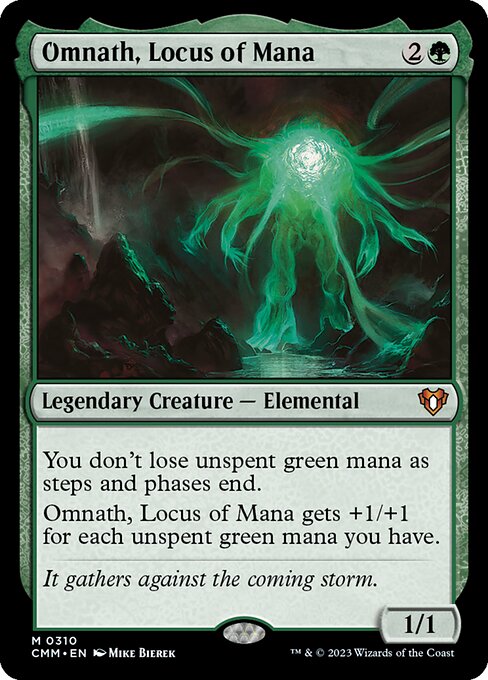
Omnath, Locus of Mana
Omnath redefines how you use mana by letting green mana float through phases without emptying. On top of that, he grows bigger for each unspent green mana you hold, making him both an engine and a potential win condition. Every ramp spell or mana dork you play makes him stronger and stockpiles for future turns.
He fits best in mono-green ramp strategies, and while he isn’t an Elf himself, he can still helm an Elf tribal deck built around massive mana production. Elfball lists in particular love Omnath – the more Elves you tap for mana, the bigger he becomes, and the more power you can store up for sudden bursts.
Doubling Cube and Nyxbloom Ancient multiply floating green mana to accelerate Omnath’s growth, while Bear Umbra and Wilderness Reclamation untap lands to bank even more resources. Creatures such as Selvala, Heart of the Wilds and Karametra’s Acolyte also convert power and devotion into massive mana to keep the engine running.
Green-White Elf Commanders
Adding white gives Elves access to lifegain, anthem effects, and token-doubling support. These decks are still ramp-heavy and combat-focused, but with stronger staying power and resilience through lifegain. They also tend to lean into go-wide strategies that benefit from doubling tokens or buffing the entire board.
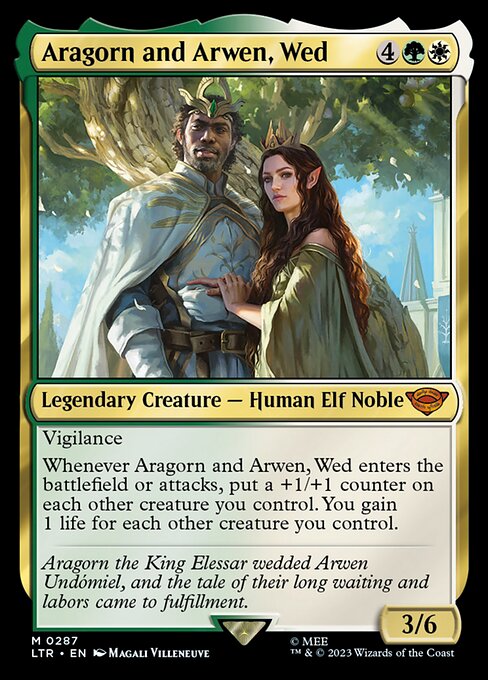
Aragorn and Arwen, Wed
Aragorn and Arwen bring resilience and steady growth to Elf tribal. With vigilance and a 3/6 body, they’re hard to push off the board, and each time they enter or attack you put a +1/+1 counter on every other creature you control. On top of that, you gain life equal to the number of creatures you control, padding your life total while your board grows.
They thrive in go-wide Elf strategies that want both scaling power and staying power. Unlike commanders that aim to win in one strike, Aragorn and Arwen provide steady incremental advantage, making them ideal for midrange or lifegain-focused Elf builds.
Cathars’ Crusade and Good-Fortune Unicorn compound their counter theme, ensuring every trigger grows your army even further. For lifegain synergy, Well of Lost Dreams can turn their attack triggers into consistent card draw, while Shalai, Voice of Plenty protects both your board and your growing life total.
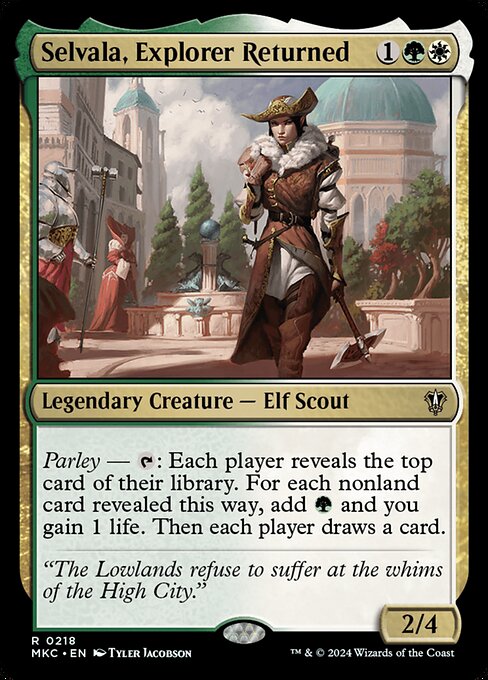
Selvala, Explorer Returned
Selvala’s parley ability turns the whole table’s draws into ramp and lifegain for you. Tapping her gives everyone a card, but for each nonland revealed you get a burst of green mana and incidental life. This makes her both a political piece and an engine that fuels your plays faster than most opponents can keep up.
She works well in token-heavy Elf decks or group-hug strategies where you can use the extra mana to flood the board. Because she encourages card draw for everyone, she also works best in environments where the temporary alliances from parley can keep opponents focused on each other while you build your advantage.
Seedborn Muse is a standout partner, letting you parley on each player’s turn for maximum value. Illusionist’s Bracers or Rings of Brighthearth double her activations, effectively turning one tap into two or more parley triggers.
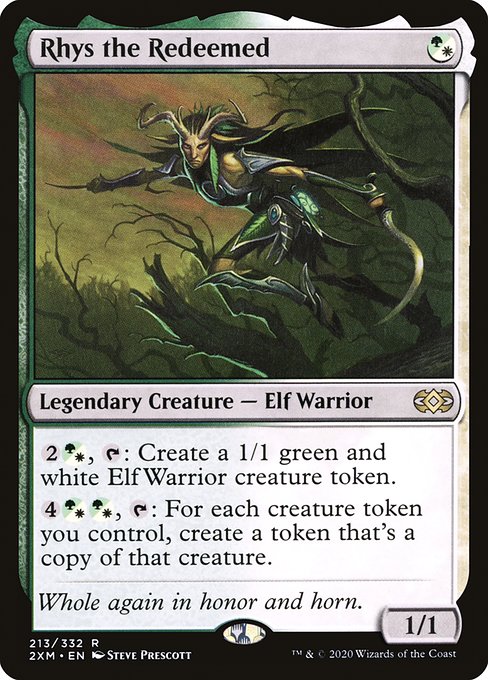
Rhys the Redeemed
Rhys may cost only one mana, but he’s a solid choice as a token commander. His first ability makes steady 1/1 Elf Warrior tokens, but his second ability doubles every token you control – not just Elves, but any type. This lets him snowball faster than almost any other tribal commander once you’ve established a board. At six mana, his second ability is quite pricey, but if any creature type can generate enough mana to pay for it, it’s elves.
He shines in go-wide Elf builds and token-focused strategies that can consistently generate bodies. With Rhys in the command zone, even small token producers become terrifying once his doubling ability comes online. He’s equally dangerous in pure tribal lists or hybrid token builds that branch into Saprolings, Soldiers, or Treasures.
Black-Green Elf Commanders
The Golgari commander approach to Elves mixes explosive ramp with attrition and graveyard value. Black adds removal, discard, and aristocrats-style payoffs, making black-green Elf decks harder to disrupt and more punishing in long games. They excel at generating card advantage through death triggers and recursive synergies.
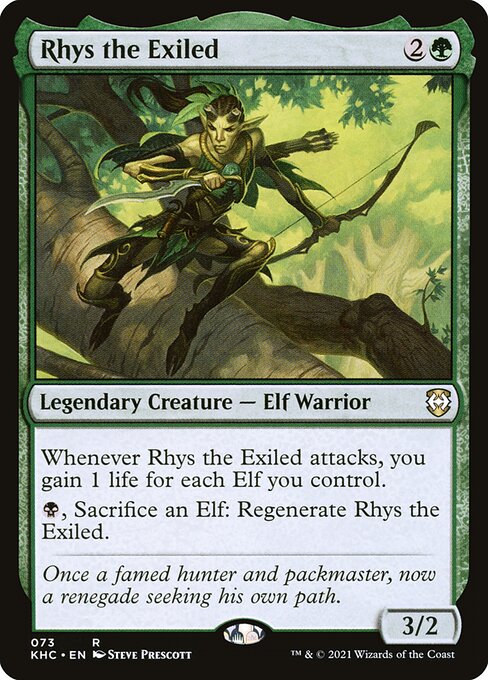
Rhys the Exiled
Rhys trades on resilience and lifegain. Each time he attacks, you gain life equal to the number of Elves you control, stabilising your life total even in aggressive builds. His ability to regenerate by sacrificing an Elf makes him very difficult to remove, provided you have the spare creatures to protect him.
He thrives in aggressive Elf tribal decks that want to pressure combat while sustaining themselves with lifegain. The sacrifice outlet also gives him a place in aristocrats-style lists, where tokens can both fuel his survival and enable death-trigger synergies.
Skullclamp pairs perfectly, letting you turn sacrificed Elves into cards while keeping Rhys alive. Shaman of the Pack makes use of all those extra bodies by draining opponents, and Eldrazi Monument offers another layer of protection while feeding his sacrifice theme.
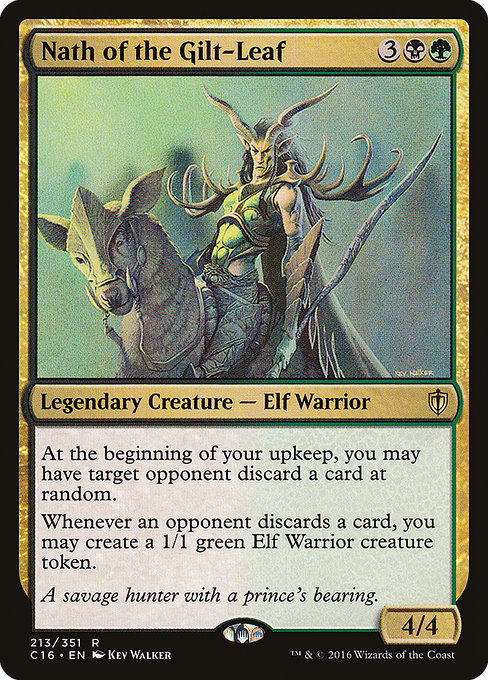
Nath of the Gilt-Leaf
The tyrant who strips your enemies bare while growing his own ranks.
Nath weaponises discard into board presence. At the beginning of your upkeep, he can force a random discard from one opponent, and every time an opponent discards a card, you get a 1/1 Elf Warrior token. This means his pressure scales with both time and support from other discard effects.
He thrives in grindy Golgari builds that mix Elf tribal with resource denial. Nath slows the table down by bleeding opponents of cards while simultaneously feeding your own army. He’s at his best in metas where opponents rely on holding answers – because their lost cards become your fresh creatures. Now, I personally love a discard-themed commander, but be warned, they very rarely make you popular with your play group!
Oppression and Bottomless Pit lock opponents into constant discards, ensuring Nath churns out tokens every turn cycle. Mind Slash gives you targeted discard while doubling as a sacrifice outlet, and Grave Pact turns every token death into removal, locking the board under your control.
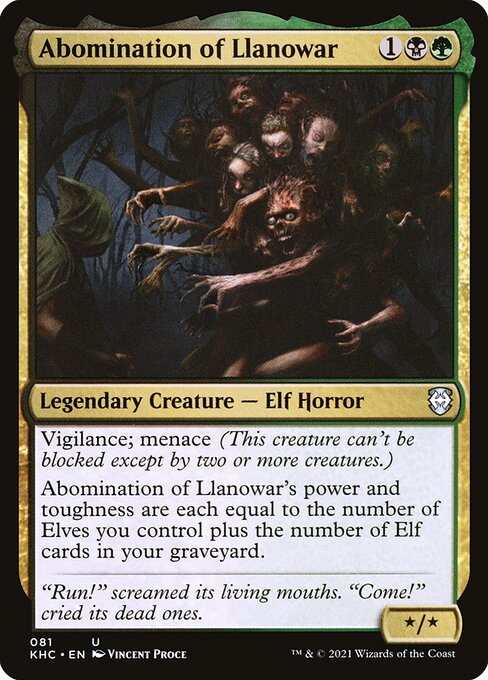
Abomination of Llanowar
Abomination of Llanowar is a scaling commander whose stats reflect both the Elves you control and those resting in your graveyard. With vigilance and menace, it pressures opponents in combat while still holding back on defense, and it naturally grows larger as the game goes on.
It works well in Elf tribal decks that mix aggressive board presence with self-mill or sacrifice. Unlike purely go-wide commanders, Abomination rewards both swarming the field and feeding the graveyard, making it a natural fit for grindier Golgari strategies that want inevitability through size.
Skullclamp and Evolutionary Leap help you turn small Elves into fresh cards while growing Abomination through the graveyard. Jarad, Golgari Lich Lord offers a backup finisher by flinging Abomination’s massive stats at opponents. For recursion, Moldervine Reclamation keeps your engine flowing while ensuring every death fuels both card draw and your commander’s power.
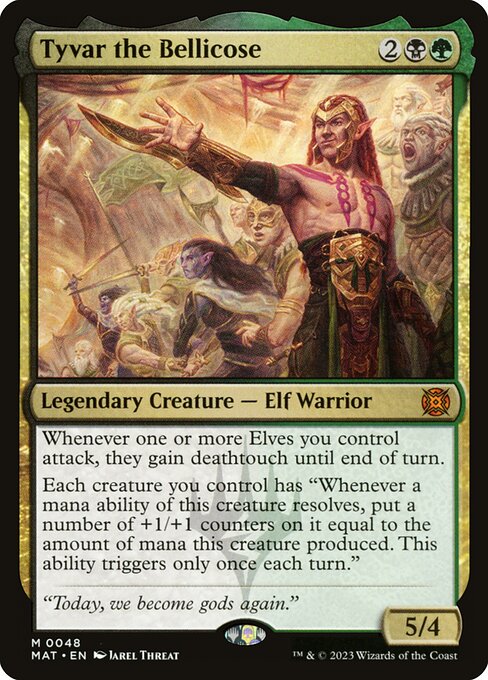
Tyvar the Bellicose
Tyvar brings two dangerous abilities to the table. First, he gives your Elves deathtouch whenever they attack, making even small tokens deadly in combat. Second, he pumps up your mana dorks – each one gets +1/+1 counters equal to the mana they produce, once per turn. That means every Llanowar Elves or Priest of Titania grows stronger just by doing its job.
He thrives in Elf tribal decks that combine aggression with mana ramp. The deathtouch ensures your board trades up in combat or forces through damage, while the counter ability scales your army into big threats as you ramp. Tyvar leans naturally into builds that want both explosive mana and combat dominance.
Priest of Titania and Bloom Tender are standouts, growing rapidly into enormous creatures while giving you plenty of mana for spells. Umbral Mantle turns any of those big mana dorks into infinite mana and infinite counters under Tyvar’s watch. Even Quest for Renewal becomes a nightmare here, letting you untap your Elves and double-dip on both mana and counters every turn cycle.
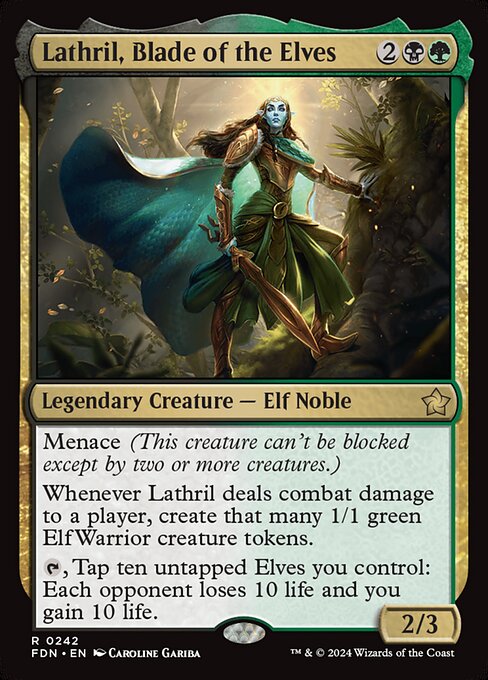
Lathril, Blade of the Elves
Lathril brings token generation and a built-in win condition. Each time she damages a player in combat, you create that many Elf tokens, quickly snowballing a small board into an overwhelming horde. Her activated ability turns that horde into direct damage, draining each opponent for 10 life while you gain 10, giving Elf tribal a reliable noncombat finisher.
She excels in go-wide Elf decks that want both swarm tactics and inevitability. Her menace makes it easier to sneak through damage early, and once the tokens start piling up, she dominates the late game with her drain ability. She’s a flexible commander who can pivot between aggro, midrange, and combo playstyles. There’s a good reason she’s one of the most popular elf commanders out there right now!
Wirewood Channeler and Marwyn, the Nurturer shine here, turning the massive number of tokens she creates into enormous amounts of mana. Benefactor’s Draught is another sneaky synergy, letting you untap your Elves to re-use her 10-creature tap ability.
Green-Blue Elf Commanders
Simic Elves combine mana ramp with powerful card draw and +1/+1 counter themes. Blue brings consistency and utility, helping Elf decks chain their spells, refill their hand, and grow steadily stronger. These builds often lean into value engines and scaling over pure aggression.
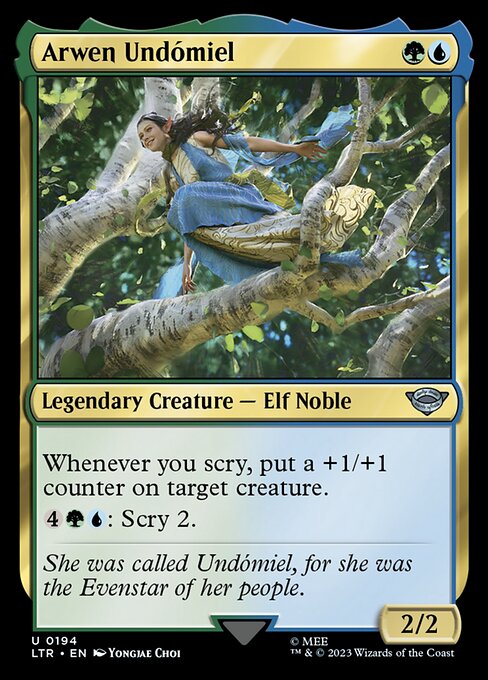
Arwen Undómiel
Arwen rewards you for scrying by turning each look into permanent growth. Every time you scry, you put a +1/+1 counter on a creature, letting you steadily build threats while sculpting your draws. Her activated ability also gives you a built-in way to scry, ensuring her engine never runs dry.
She’s best in Simic decks that blend Elf tribal with scry and counter synergies. Unlike pure Elfball commanders, Arwen slows the pace slightly, focusing on building advantage and precision rather than overwhelming with tokens alone.
Mystic Speculation is a perfect fit, letting you buy back and repeatedly scry to stack counters. Courser of Kruphix ensures consistent value from top-deck knowledge while feeding Arwen’s counter plan. For tribal synergy, Master Biomancer makes her engine even more potent, ensuring every Elf enters the battlefield already loaded with counters.
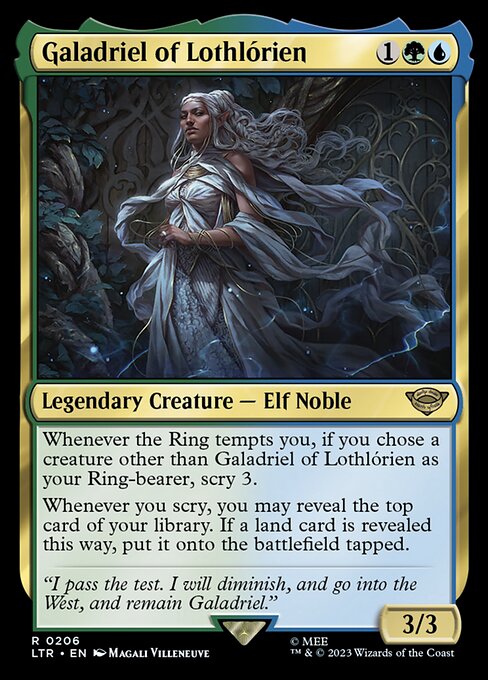
Galadriel of Lothlórien
Galadriel blends scrying with ramp, letting you scry 3 whenever the Ring tempts you and you decline to make her the Ring-bearer (which I’m sure the Lord of the Rings nerds out there will agree is a wonderful flavor mechanic). On top of that, whenever you scry, you may reveal the top card of your library, putting a land directly onto the battlefield if it’s revealed. This makes her both a card-quality engine and a subtle land ramp tool.
She thrives in Simic builds that value card manipulation and incremental advantage. Elf tribal shells can use her to smooth out draws while ramping naturally, but she also works in more general scry-focused decks that want reliable land drops and steady development. Similar to Arwen, she’s not a conventional ‘elf commander’, but is an elf that can be used as a commander that brings an interesting twist to the creature type.
Cards like Elven Farsight and Preordain reliably trigger her scry ability while smoothing your draws. Retreat to Coralhelm and Lost Isle Calling add repeatable scry engines that double as value pieces, and Birthday Escape is a cheap way to trigger her first ability by having the ring tempt you.
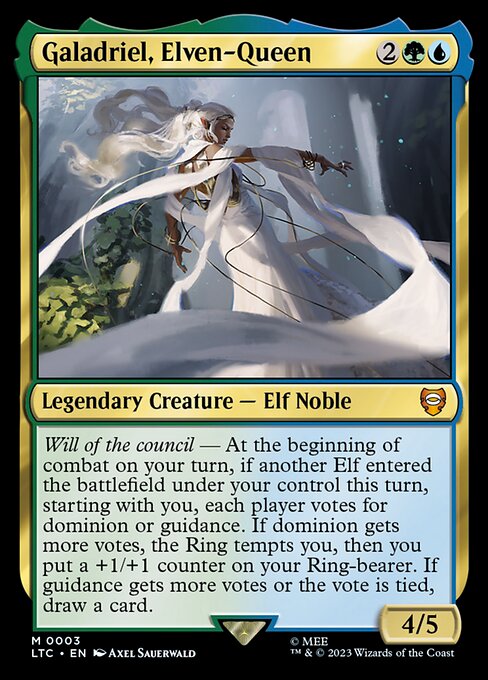
Galadriel, Elven-Queen
This version of Galadriel introduces political play to Elf tribal with her will of the council ability. Each combat, if you had an Elf enter the battlefield, players vote: dominion tempts you with the Ring and grows your Ring-bearer, while guidance nets you a card instead. Either way, you come out ahead by playing to the table’s mood.
She thrives in Elf tribal decks that consistently produce creatures, since her ability requires an Elf to enter each turn. The combination of card draw and Ring synergies makes her flexible: she can lean into incremental advantage, or set up long-term pressure through repeat temptation triggers.
Galadhrim Ambush and Windswift Slice both generate Elves to guarantee her council vote while also serving as removal or protection. Raise the Palisade further cements tribal dominance by clearing away non-Elves and leaving your army intact.
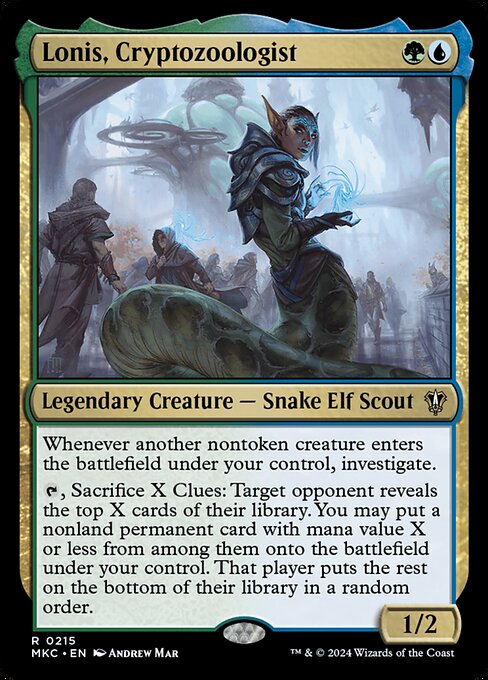
Lonis, Cryptozoologist
Lonis generates Clue tokens whenever another nontoken creature enters your battlefield, giving you consistent card draw or fuel for his second ability. By sacrificing Clues, you can steal nonland permanents straight off an opponent’s deck, turning investigation into a powerful form of advantage.
He shines in Simic builds with a high creature density, where constant entries keep the Clues flowing. Again, this is another commander that deviates from the tried and tested elf-formula as he doesn’t technically need elves to function. Still, a cool commander, nevertheless.
Tamiyo’s Journal doubles down on Clue generation and gives you a tutor when needed. Academy Manufactor is absurd here, turning every Clue into a Treasure and Food token as well.
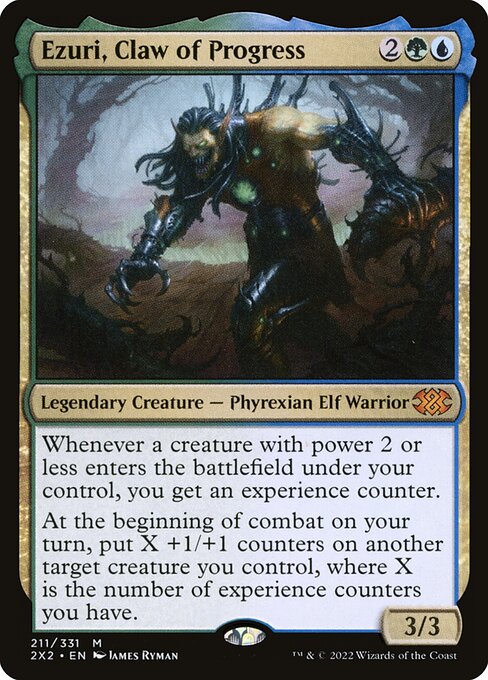
Ezuri, Claw of Progress
Ezuri turns your smallest creatures into long-term fuel. Each time a creature with power 2 or less enters, you gain an experience counter. At the start of combat, he converts those counters into +1/+1 counters on one of your creatures, scaling it into a massive threat over time.
He excels in Elf tribal lists filled with mana dorks and utility creatures, since almost all of them naturally have power 2 or less. Over the course of the game, Ezuri transforms your early ramp pieces into the foundation for an unstoppable finisher, blending swarm strategies with a “go-tall” centerpiece.
Fathom Mage and Cold-Eyed Selkie turn Ezuri’s counters into reliable card draw, while Champion of Lambholt and Herald of Secret Streams make the team nearly unblockable. For bigger swings, Sage of Hours can cash in counters for extra turns, while Gyre Sage and Incubation Druid ramp harder as your experience builds.
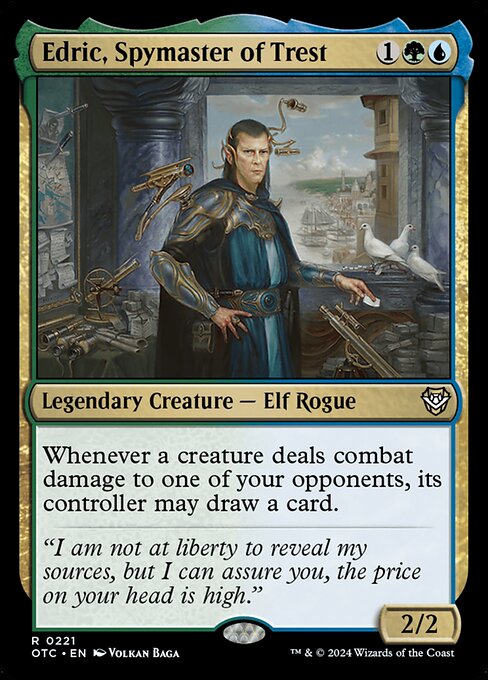
Edric, Spymaster of Trest
Edric warps the table by offering card draw to anyone attacking your opponents. Every creature that connects with an opponent draws its controller a card, which often means your rivals are incentivized to swing anywhere but at you. In the meantime, your own evasive creatures keep your hand overflowing.
He thrives in Elf tribal decks that can produce lots of small, evasive bodies, or in political builds that rely on table dynamics. Instead of brute force, Edric uses subtlety: opponents either feed you and themselves cards or fall behind as the rest of the table takes advantage.
Unblockable one-drops like Slither Blade, Triton Shorestalker, and Mist-Cloaked Herald guarantee steady card draw from Edric. Tetsuko Umezawa, Fugitive takes the plan to new heights by making all your tiny evasive creatures unblockable, while Notorious Throng turns that card advantage into an instant win condition with a flood of Faerie tokens and even an extra turn. For utility, Druids’ Repository converts your endless swarm of attackers into mana, keeping your advantage snowballing.
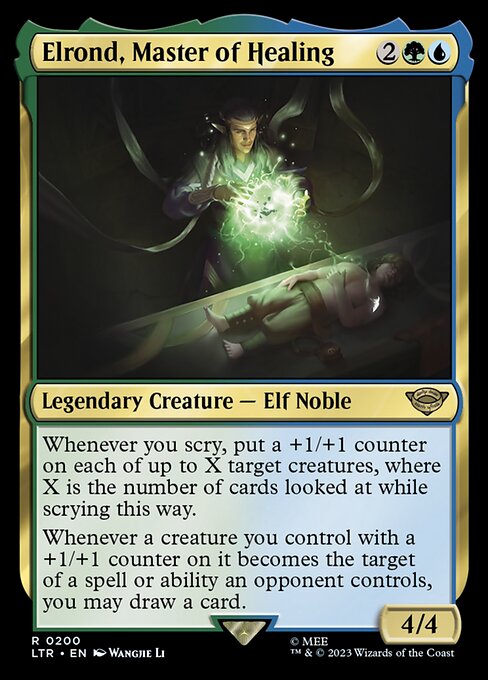
Elrond, Master of Healing
Elrond transforms scrying into a counter engine, letting you distribute +1/+1 counters based on how many cards you look at. On top of that, he punishes opponents for interacting with your creatures – every time one of your counter-buffed creatures is targeted, you draw a card. This makes him both proactive and defensive in equal measure.
He thrives in Simic counter-focused Elf decks or scry-heavy builds. With his ability, every scry becomes an opportunity to scale your army, while also turning opponents’ removal into card advantage for you. He encourages a strategy that blends board development with careful deck manipulation.
Including cards such as Elven Farsight, Opt, and Preordain will give you cheap, repeatable ways to trigger Elrond’s counter and draw engines. Arwen Undómiel and Celeborn the Wise double down on scry synergies, steadily scaling your board. For utility, Rivendell offers repeatable scry from a land slot, while Elvish Mariner turns scries into soft control by tapping down opposing permanents.
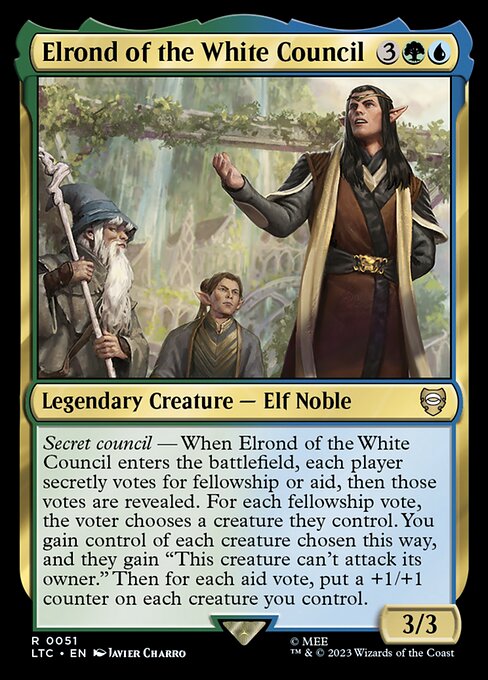
Elrond of the White Council
Elrond adds a political edge to Simic Elf decks. When he enters the battlefield, each player secretly votes: fellowship may hand you control of opponents’ creatures (albeit unable to attack their owners), while aid grows your own board with +1/+1 counters. No matter how the vote goes, Elrond ensures you come out ahead.
He thrives in multiplayer tables where politics matter. In Elf tribal, the aid vote naturally amplifies your go-wide strategy, while fellowship can give you key utility creatures from opponents to lock up the board. He’s less about raw speed and more about incremental advantage through social pressure and flexibility.
With this commander, Plea for Power and Erestor of the Council add political leverage, rewarding you no matter how opponents vote. For tribal synergy, Raise the Palisade clears away non-Elves, while Overwhelming Stampede or Arwen, Weaver of Hope turn Elrond’s counter support into massive finishing power.
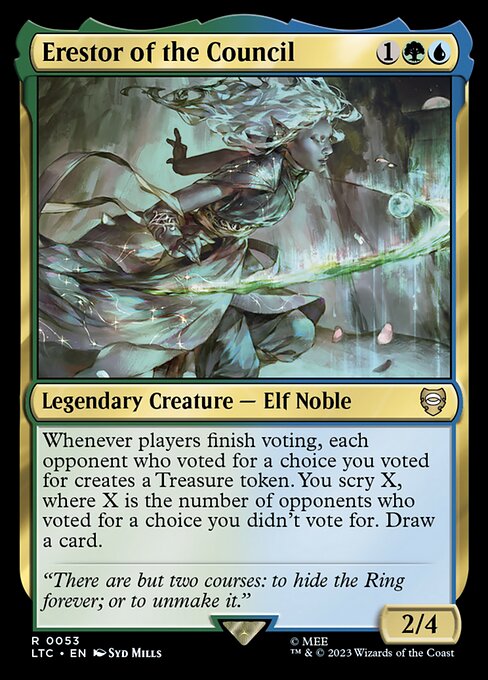
Erestor of the Council
Erestor ensures you come out ahead in every vote. If opponents agree with your choice, they get Treasures – which can curry political favor. If they disagree, you scry for each opposing vote, then draw a card. That means every vote fuels boosts either your resources or your card advantage.
He thrives in multiplayer games where voting mechanics and politics are common, such as decks using other council or will-of-the-council effects. In an Elf tribal shell, Erestor leans more toward support than raw aggression, smoothing draws and ensuring you never fall behind in resources.
Cards like Plea for Power and Sail into the West ensure you benefit no matter how players vote, while Illusion of Choice lets you dictate the outcome entirely. Círdan the Shipwright and Elrond of the White Council reinforce the council subtheme, and cards such as Selvala’s Stampede and Travel Through Caradhras turn group politics into huge board and resource swings.
Black-Green-White Elf Commanders
Abzan Elf commanders are rare, but this colour trio mixes tribal ramp with recursion and legendary-matters synergies. White adds protection and utility, black adds graveyard power, and green keeps the deck flowing with mana and creatures. The result is a more toolbox-style Elf deck with flexible answers.
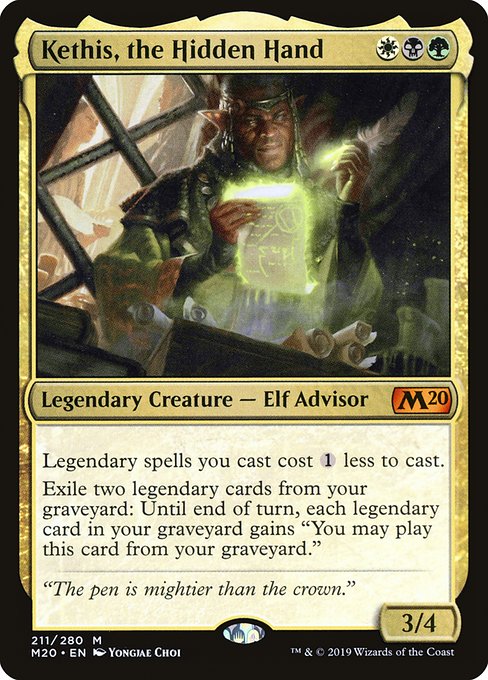
Kethis, the Hidden Hand
Kethis reduces the cost of all your legendary spells, making your key pieces easier to deploy. More importantly, he lets you exile two legendary cards from your graveyard to give the rest of your legendary graveyard a temporary second life, effectively turning it into an extension of your hand.
He thrives in Elf tribal lists packed with legendary creatures, or in hybrid builds where Elves mix with legendary-matters synergies. His ability ensures that even if opponents remove your best cards, you can keep recycling them for value, making him one of the grindier options for Elf tribal.
Urza’s Ruinous Blast and Primevals’ Glorious Rebirth are devastating payoffs, clearing away nonlegendaries or reviving an entire board once your graveyard is stocked. Reki, the History of Kamigawa and Vraska Joins Up keep the cards flowing every time you cast another legend, while Ratadrabik of Urborg ensures your legendary creatures stick around even after they die. For value, The Kenriths’ Royal Funeral doubles as card draw and cost reduction, making it even easier to churn through legends with Kethis.
Green-Red Elf Commanders
Red adds speed, damage, and extra combat to traditional Elf tribal. These decks push the pace with aggressive swings, turning mana dorks into real attackers and capitalising on combat-focused finishers. It’s less about grindy value and more about overwhelming opponents before they stabilise.
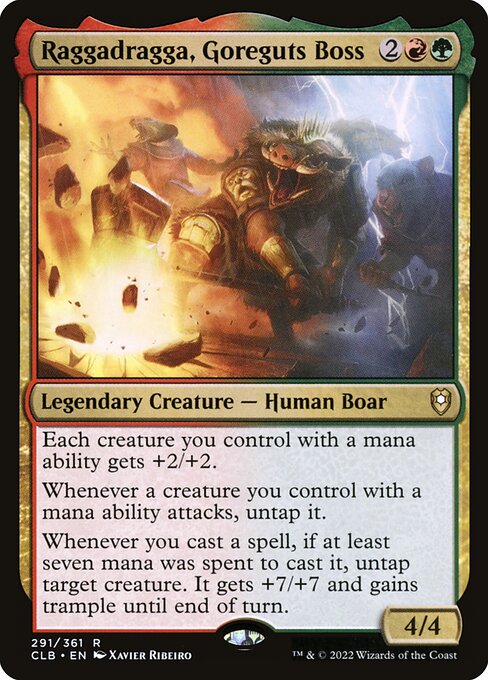
Raggadragga, Goreguts Boss
Raggadragga supercharges any creature with a mana ability, giving them +2/+2 and letting them untap when they attack. This means that your simple mana dorks, like Elves, not only ramp you but also become efficient attackers. His final ability rewards big-mana spells with a +7/+7 trample boost, providing explosive finishing potential.
If we’re being honest – Raggadragga isn’t technically an elf commander, however, there are a lot of elves with mana abilities, so it just kind of works. He thrives in Gruul Elf decks that lean heavily on mana dorks and big plays. Instead of sitting back to ramp, your Elves can attack, untap, and still generate mana – doubling their effectiveness. Raggadragga blurs the line between Elfball ramp and Gruul stompy, rewarding decks that want to play both fast and hard.
Raggadragga thrives when backed by mana dorks that can turn into bruisers. Viridian Joiner and Marwyn, the Nurturer both scale into enormous threats while fueling your biggest plays, while classics like Llanowar Elves, Elvish Mystic, and Fyndhorn Elves become dangerous attackers thanks to his buffs. For added punch, Leyline of Abundance doubles the mana your creatures produce, and Radha, Heir to Keld or Ruby, Daring Tracker supply extra aggression alongside ramp.
Green-Red-White Elf Commanders
Naya colours blend Elf ramp with red’s aggression and white’s anthem effects. This identity is all about combat dominance, pumping your team, and ensuring you always have trample or evasion. It’s perfect for players who love big creature battles and token synergies.
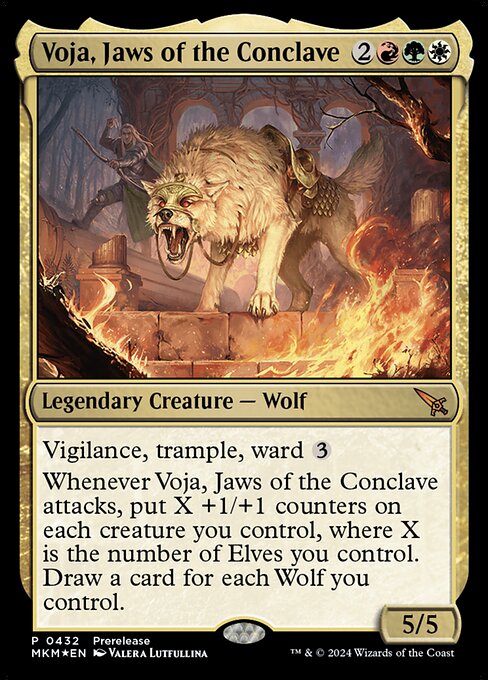
Voja, Jaws of the Conclave
Voja is a combat powerhouse, bringing vigilance, trample, and ward to the table as a hard-to-remove 5/5. When he attacks, he spreads +1/+1 counters to your whole team equal to the number of Elves you control, while also rewarding Wolf tribal builds with card draw. This dual synergy makes him uniquely flexible.
He thrives in Naya Elf decks that want to go wide and swing hard. The Elf half of his ability ensures your army scales rapidly, while Wolves add card advantage to give you plenty of options. Even without the Wolf support, Elf tribal alone makes Voja’s attack trigger devastating, as each combat compounds your board’s size.
Voja really shines when supported by both sides of its identity. Wolf-makers like Hollowhenge Overlord, Howling Moon, and Wren’s Run Packmaster steadily build a threatening pack, while Tolsimir, Friend to Wolves or Tolsimir, Midnight’s Light turn those Wolves into removal and lifegain engines. On the Elf side, Elvish Archdruid and Llanowar Elves fuel the mana you need to keep pressure high, with Voja turning that resource advantage into card draw and a massive board of counters.
Green-Blue-White Elf Commanders
Green, blue, and white combine to give Elf decks a perfect mix of ramp, card advantage, and resilience. These colors let your tribe grow tall with counters, go wide with tokens, and keep the engine stocked up with constant draw. Bant Elves don’t just overwhelm – they adapt, protect their board, and snowball value into an unstoppable late game.
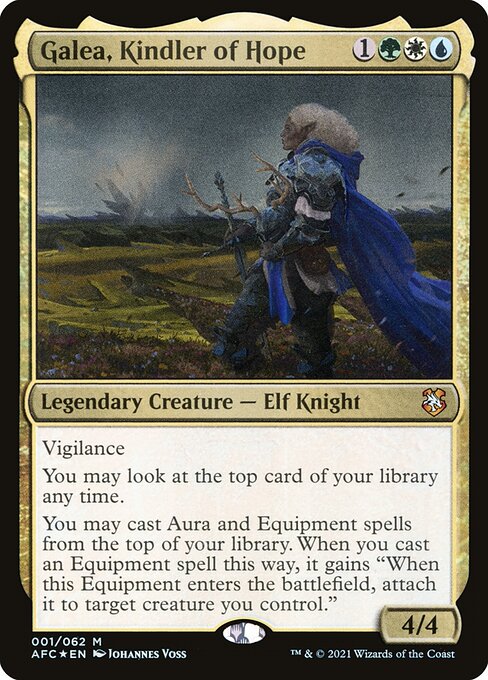
Galea, Kindler of Hope
Galea mixes Elf tribal with Voltron strategies in a unique way. She gives you constant knowledge of your top deck, and lets you cast Auras and Equipment directly from it. Better still, any Equipment cast this way auto-attaches to one of your creatures, saving time and mana.
She thrives in Bant builds that want to blend Elf synergies with Aura and Equipment packages. Elves provide the mana ramp and board presence, while Galea ensures your biggest threats are always armed and ready. This makes her a natural fit for players who like tribal decks with a Voltron twist.
Sram, Senior Edificer and Puresteel Paladin reward you with extra draws as you deploy Auras and Equipment, while Danitha Capashen, Paragon reduces their cost to keep the flow going. Heavy hitters such as Colossus Hammer and Mantle of the Ancients transform even the smallest creature into a lethal threat, and Holy Avenger can double the pressure with burst damage. For consistency, Sword of the Animist accelerates your mana base, and Robe of Stars keeps your key threats safe from removal.
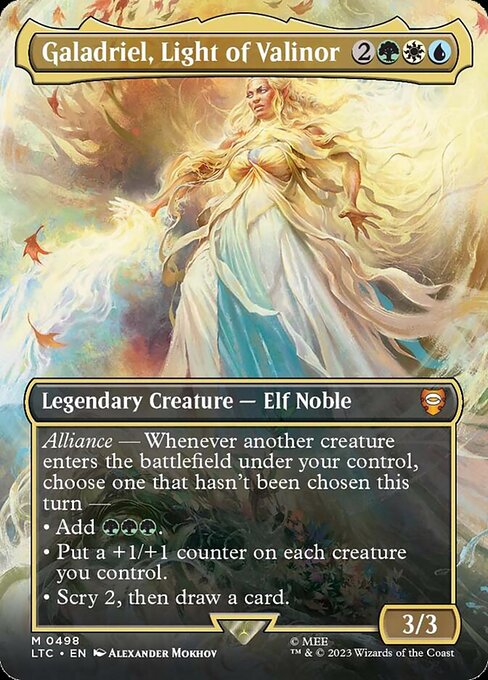
Galadriel, Light of Valinor
Galadriel (yes, another one) embodies versatility, with her alliance trigger giving you three different rewards whenever a creature enters your battlefield. Each creature that arrives offers either a burst of mana, a team-wide +1/+1 counter, or card selection and draw – but you can only pick each option once per turn. This makes her both flexible and rewarding in wide token strategies.
She thrives in Bant Elf tribal or token-heavy builds, where creatures are constantly entering the battlefield. The mana option helps you snowball into bigger plays, the counter mode scales your army as you swarm, and the card draw keeps your hand full. In practice, Galadriel ensures that no creature is ever “just another body” – each one advances your game plan in a meaningful way.
Ramp pieces such as Elvish Mystic and Llanowar Elves ensure you hit Galadriel early, while Elvish Warmaster and Galadhrim Brigade flood the board to maximize her Alliance triggers. Flexible support from Reclamation Sage and Galadriel’s Dismissal keeps you safe, while Galadhrim Ambush and Gala Greeters translate creature swarms into tokens, life, or counters.
Mono-Black Elf Commanders
Rare but flavourful, mono-black Elves lean hard into aristocrats strategies. Without green’s ramp, they play differently than traditional Elfball, focusing instead on lifedrain, sacrifice loops, and grindy card advantage. It’s a niche but exciting take for players who want a darker spin on Elf tribal.
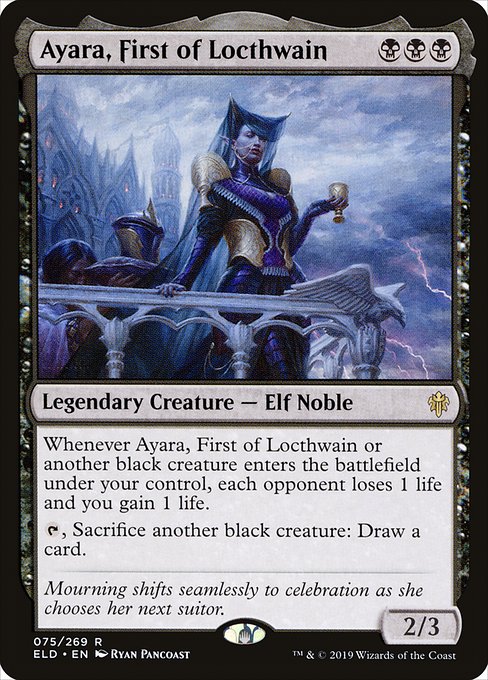
Ayara, First of Locthwain
Ayara bleeds the table each time she or another black creature enters, draining opponents while padding your life total. On top of that, she provides steady card advantage by letting you sacrifice another black creature to draw. This gives her both inevitability and resilience in longer games.
She thrives in mono-black builds that lean into aristocrats-style play. Token producers turn her into a steady drain engine, while the sacrifice outlet doubles as a way to dig for answers or keep the board flowing. In all honesty, Ayara isn’t your average elf commander, and as a mono-black commander, it’s unlikely there will be many elves at all in this deck.
Ayara thrives in token-heavy sacrifice shells. Jadar, Ghoulcaller of Nephalia and Ophiomancer keep a steady stream of fodder flowing, while drain effects from Zulaport Cutthroat or Bastion of Remembrance turn each death into reach. Big payoffs like Abhorrent Overlord or Army of the Damned flood the board to supercharge her triggers and quickly overwhelm opponents.
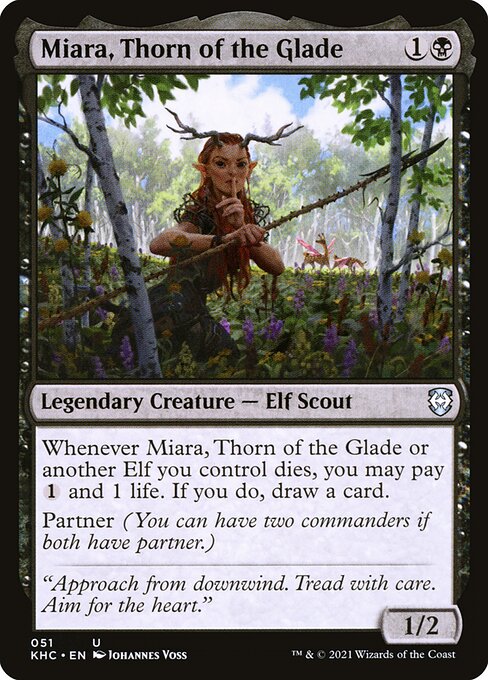
Miara, Thorn of the Glade
Miara turns death into card advantage. Whenever she or another Elf you control dies, you can pay and 1 life to draw a card. This gives you a steady way to convert your small creatures into resources, ensuring your hand stays full even as your board gets cleared.
She shines in aristocrats-style Elf builds, especially ones that produce plenty of expendable tokens. As a Partner commander, Miara also pairs well with green legends that generate Elves, giving you a natural balance between supply (tokens) and payoff (card draw).
Pairing Miara with Numa, Joraga Chieftain reinforces classic Elfball, combining Miara’s draw with Numa’s counter distribution. Nadier, Agent of the Duskenel leans into tokens and sacrifice synergies, while Thrasios, Triton Hero or Kydele, Chosen of Kruphix open up Sultai-style value and ramp. Aggressive builds can turn to Tana, the Bloodsower or Kamahl, Heart of Krosa for go-wide pressure, with Gilanra, Caller of Wirewood offering simple ramp support.
Conclusion – Why Elves Remain a Commander Powerhouse
Elves have stood the test of time as one of the most explosive and reliable tribes in Commander. From classic leaders like Eladamri, Lord of Leaves to modern powerhouses like Lathril, Blade of the Elves, they offer unmatched mana acceleration, board presence, and synergy. Whether you want to storm the table with an unstoppable Elfball combo, grind value with midrange buffs, or mix in offbeat synergies like legendary-matters or token doubling, there’s an Elf commander perfectly suited to your style.
Their biggest draw is consistency – almost every Elf contributes to the deck’s overall plan, whether it’s ramp, combat buffs, or card draw. Even after a setback, Elf decks can rebuild quickly and threaten lethal in just a turn or two with the right pieces. Add in the variety of colour combinations available, and you’ve got a tribal archetype that can fit almost any playstyle.
If you’re ready to command a warband that grows stronger with every draw and overwhelms the table with the might of the forest, an Elf kindred deck is one of the most satisfying and powerful choices you can make in Commander. Gather your champions, untap your mana dorks, and let the green tide roll.
